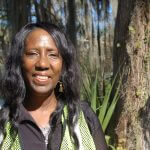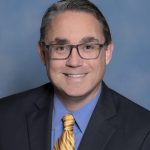Iyana Simba
Chicago, Illinois
Previously, she served in several roles at IEC, including Clean Water Policy Director, Clean Water Advocate, and Intern. In her most recent role as Clean Water Policy Director, she oversaw policy development, coalition building, and advocacy related to water issues in Illinois. Iyana’s work continues to ensure water, among other environmental issues, are salient to both the public and decision-makers. Iyana currently co-leads the Illinois Water Justice Coalition, which works toward equity and justice in water infrastructure decisions. In 2024, Iyana was named a Wavemaker by the Alliance for the Great Lakes in recognition of her coalition work. Additionally, she has served on the Illinois Lead Service Line Replacement Advisory Board since 2022 and was previously a member of the Chicago Lead Service Line Replacement Advisory Group before it was dissolved in early 2023.
Prior to working at IEC, she attended the University of Illinois at Chicago and graduated with honors with a degree in Public Policy and a Sustainable Cities minor. Outside of her work, Iyana enjoys engaging in local politics, painting, hiking, and traveling. She is also a member of the Environmentalists of Color Network and the Chicago Urban League’s Metropolitan Board.
This interview was conducted by Carly Schmidt on July 15, 2021. Learn more about Iyana’s work at https://ilenviro.org/.
What is your role at Illinois Environmental Council (IEC) and how did you first get involved with drinking water issues?
I am IEC’s Clean Water Policy Director and that means that I oversee IEC’s coalition building, policy direction, community engagement, research, and pretty much anything related to water issues in Illinois. I especially work on coalition building and policy drafting and then just general advocacy and education. So, one, educating lawmakers on water issues and then also educating the public and trying to raise public pressure on elected officials. I got involved with water issues because a long time ago, when I was 12, my dad and I did a river clean up in Lansing and we found a bunch of really messed up stuff like bikes, TVs, all kinds of bad things. It made me start thinking more and more about water. When I started interning at IEC, there was a grant opportunity from the Mott Foundation for a water position and that’s how I ended up doing what I’m doing now.
There are many facets related to clean drinking water, including issues of access, quality, affordability, and safety. Where do you focus your work? Do you primarily work at the local (city/county), state, regional or federal level?
We pretty much cover them all. I do a lot of work on affordable drinking water, focusing on water systems and affordability. I also work on water access issues, focusing more on lead pipes, lead in drinking water, and PFAS contamination. Our conservation and agriculture teams focus on the impact of agriculture and green infrastructure on water and, in general, water quality stuff that has more to do with the land adjacent to it. That work covers local, state, and regional, and now we are doing federal work. Right now, that federal work means looking at the American Rescue Plan Act (ARPA), seeing how much has been outlined for water and how we can advocate for federal funding. But a lot of our work is at the state and local level, and a little bit at the regional level. We are working with the Ohio Environmental Council, Freshwater Future, and other folks to figure out what else is happening around clean water that we can all focus on.
Illinois Environmental Council worked to pass House Bill 3739, the Lead Service Line Replacement and Notification Act in Illinois, requiring water utilities to replace all lead service lines statewide. What was the impetus to develop and implement this policy?
The tipping point was the Flint Water Crisis. Prior to that, there were definitely issues with lead in drinking water. Illinois has 1/8 of all lead service lines within the United States. There are over 400,000 lead service lines in Chicago. That is what pushed this whole drive to get rid of lead service lines; that’s where the impetus came from. Over the past couple of years, we’ve worked to pass a law that requires lead testing in daycare and home childcare facilities. We also passed a bill that requires testing in schools.
We need all municipalities to come up with a plan for lead service line replacement. There have been several different smaller programs around the state, but there needs to be a statewide program with state funding because we can’t keep pushing this issue down the line. Flint was a very unique situation, another Flint crisis could happen wherever there are lead service lines.
How did you build support for this policy in terms of engaging community members, elected officials, and water utilities in the state?
For the public, knowing about the Flint water crisis had already built some additional support. Also continuing to do education: town halls, talking about the dangers of lead, trying to pass different legislation, and really honing in on the impact of lead on children. We ended up with a broader coalition because there was a lot of concern from other public health advocates.
As far as buy-in from elected officials, it’s usually about providing education, policy expertise, and really leaning on the communities that have lead service lines and encouraging them to say, “Hey, this is something that you should be addressing, you should be supporting something that removes lead from our drinking water.” In addition to education and advocacy, leveraging our relationships. IEC covers a range of environmental issues, so it’s definitely not just water. We’ve worked with these folks for the last 45 years, since 1975, so we do a lot of relationship-building with elected officials.
As far as water management service providers, it’s somewhat in the same thread. We’ve worked with them before, but it’s also about bringing them into the conversation very early on and understanding that whatever we pass will have a huge impact on water management and water utilities. Having them involved very early on in the conversation, going through a lot of negotiation, and looking at every single angle until we reach some type of compromise is how we build support with utilities.
With other coalitions, same thing. It’s about building relationships and also leveraging the fact that many community groups have direct experience with water issues. Having personal stories about the impacts of lead in drinking water builds momentum for the bill. Overall, it’s about bringing everyone to the table that would be affected by lead in drinking water.
What did this process look like during the pandemic? How did you reach people when you couldn’t meet with them in person?
We continue to do the virtual town halls. As far as communication, it was a lot more check-ins, more calls, a lot more emails and; when appropriate, possible, and safe; having some direct conversations with elected officials in-person. We relied heavily on virtual tools and previous relationships that we had with elected officials which was really important in how we navigated the whole pandemic while also trying to pass something.
Passing a bill or resolution is a big accomplishment, but we know it isn’t the end of the story. HB 3739 was just passed. Looking forward, how are you going to continue to work with affected communities and/or state agencies to make sure the bill will be implemented?
We’re already started having conversations internally with our advocacy folks. Then, once they’re on board, we’ll begin having conversations with water utilities. The bill includes an Advisory Board that will oversee some of the planning of lead service line replacements, as well as the funding for it. The way to continue to support the bill is to stay in contact with people during the rulemaking process, and I think the Advisory Board will be one opportunity for collaboration between water utilities, impacted communities, and non-profit organizations. That’s really going to make sure that all of the folks are still involved in the process. I think continuing to keep fire to the flame, or whatever you want to call it, the Advisory Board is going to play a huge role in that.
What have been the biggest hurdles or challenges facing your organization as you work on drinking water issues?
I think COVID has shifted how we talk about water issues. Prior to the pandemic, a lot of our focus was on lead, PFAS, coal tar, and other water contamination issues. With COVID, we switched to affordability because there were people that didn’t even have access to clean water. Before we could think about how coal tar affects wildlife, we had to start thinking about who actually has access to water and is it actually affordable? It wasn’t a hurdle, but it was a challenge to shift how we talk about drinking water issues.
Water issues are being exacerbated by climate change, especially with flooding and stormwater management. There’s still been a sluggish response. One of the biggest challenges has just been building collective public outcry about water issues. I think COVID actually helped in terms of water access and affordability arguments, but I think that more education is needed in order to build momentum for water policy. I think it’s something that people haven’t thought about. I don’t think people understand that the water you’re drinking could have contamination issues. It could be happening to you, in Chicago, in your apartment, and you wouldn’t even know.
What are the major campaigns or policy priorities that you’re currently working on? What kind of strategies are you using to advance your goals?
Right now, our biggest focus is on water assistance and affordability. Through the lead bill we have a low-income water assistance program that the state is designing. We also have Chicago’s Utility Billing Relief Program, which is another water assistance program. Lead service line replacement is obviously still a huge policy priority. And, generally, using federal dollars from the American Rescue Plan Act and thinking about how they can be applied to water issues. Also, reducing PFAS contamination in water. We passed a bill that phases out PFAS used in firefighting foam, but we still have to have action levels set. As far as strategy goes, I can’t speak to every single one, but continuing to make sure that the way the lead and service line replacements are equitable. We’re trying to build up education and create a statewide water coalition that can build up that public outcry that we’re wanting. Even though we’ve had amazing water victories this past session, we still need to continue the urgency in order to do something next year. Because COVID is going to continue to have an impact, years and years out, we still need funding for water infrastructure and green infrastructure. We still need to address PFAS. The general theme across the board is continuing to build elected and public awareness of water issues.
What’s your biggest accomplishment to date? What aspect of your work are you most proud of?
My biggest accomplishment to date… it may be the lead service line replacement bill. I’ve been here for three years, and every single year I’ve seen it introduced, tried to pass it, introduced, tried to pass it. To me, it’s an example of a policy victory story, in which it may not happen once, it may not happen the second time, it may not happen the third time, but eventually, you will be able to get something passed. Emphasizing the point of continuing to raise issues does lead to actual policy results. I think that is a huge accomplishment for IEC.
As part of IEC, I’m proud of the way we’re trying to continue to work with community and EJ [environmental justice] partners. Over the last couple of years, we have really been trying to have EJ community groups lead, telling us what they need. We are a white-led organization and, instead of leading the charge, we are checking in before making a lot of policy decisions. We are building better accountability structures, so that’s something I’m really proud of implementing in my water work.







